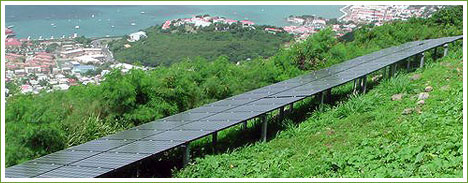I recently went on vacation in the Caribbean and stayed on St. Thomas of the US Virgin Islands. It was beautiful, sunny, and the water was clear. I happened to discuss Energy Corps with a cab driver named Conrad. He mentioned that they have Peace Corps members on the island, and Energy Corps could play a large role, as well. I began to wonder what kind of difference Energy Corps could make in a place with such tremendous needs.
Energy Crisis
In 2010, the USVI’s energy supply came strictly from fossil fuels, and the Virgin Islands have some of the steepest energy prices under the US. United States energy costs in January 2012 averaged 9.61 cents for all sectors. The US Virgin Islands costs averaged 47 cents per kWh. That’s almost 5x the US average. That normal $150.00 summer electric bill you get, would be $700.00 in the USVI. To combat this, the islands work hard to install solar panels and other renewable energies. They are in a prime location with abundant solar and wind resources waiting to be harnessed. The US Virgin Islands could pave the way for other island nations to develop renewable energies and stabilize the economy.
The EIA website explains sources of power for the islands:
Electricity in the Virgin Islands is produced almost entirely by oil-fired generators using No. 6 heavy fuel oil and No. 2 diesel fuel… Two electric power plants, the Richmond plant…on St. Croix and the Randolph E. Harley plant…on St. Thomas, supply electricity to the islands. The Harley plant generates electricity for St. Thomas, St. John, Hassel Island, and Water Island. The three smaller islands are supplied with electricity by underwater cable. St. John also has an emergency diesel-fueled generating unit.
virginislandsdailynews.com
EDIN
The International Partnership for Energy Development in Island Nations (EDIN) chose USVI as a pilot project in hopes of developing renewable energies for all the island nations. EDIN aims to trim fossil fuel use down to 60% by 2025 by promoting renewable energy and efficiency.
The purpose of the EDIN V.I. project as stated on their website:
-
Increase the affordability and reliability of energy throughout the territory.
-
Build a thriving clean energy sector that generates green jobs.
-
Preserve the natural beauty that is the lifeblood of the islands.
Implemented Technologies
The runway of the St. Thomas airport has a large solar panel installation that delivers 15% of the airport’s electricity needs. Cantsink Manufacturing installed “1,834 solar photovoltaic modules with an output of 245 watts each…for a total system output of 449 kW. The modules will save the airport an estimated $15,000-$20,000 per year on electricity costs. ”
The islands have received grants, rebates, and other breaks to instate energy efficient and renewable technology. The Virgin Islands Energy Office offers at least $1,000 off of solar water heaters for residential buildings. A new code passed requires all new developments (all sectors) to install solar water heaters to cover at least 70% of the building’s water heating needs.
Different groups, like VIenergize, offer energy and environmental education, workshops, and opportunities to get involved. Energy Corps could also offer similar educational opportunities along with hands-on energy assistance in homes and other buildings in need of weatherizing or updates. The more people who have access to opportunities and help, the better the chance for change.
Future Hopes
The rising sea levels from climate change are a threatening reality in the Caribbean. On some islands like Grenada, coastal fishing villages have already been displaced by the high tides. The Virgin Islands struggle with crime and poverty. 28.9% of the population lives below the poverty line and the islands are a transit point for drugs, which bring guns and violence. The economy relies on tourism and manufacturing. Having clean and affordable energy available to the public is essential to stabilizing the economy, bringing peace to the islands, and preserving their livelihood.
ecogeek.org
Additional Resources:
http://www.vienergy.org/index.html
http://www.eia.gov/state/?sid=VQ
http://www.nrel.gov/news/press/2010/817.html
http://www.dsireusa.org/incentives/index.cfm?state=VI&re=0&ee=0&spv=0&st=0&srp=1
http://www.edinenergy.org/usvi.html
http://www.sustainablebusiness.com/index.cfm/go/news.display/id/19874
http://states.aarp.org/virgin-islands-moves-toward-more-affordable-energy-costs/
http://donnachristensen.house.gov/press-release/christensen-energy-bill-passes-subcommittee
http://www.eia.gov/electricity/monthly/epm_table_grapher.cfm?t=epmt_5_03
http://www.britannica.com/EBchecked/topic/629915/United-States-Virgin-Islands/7724/Economy
This post was originally written for wordpress.uark.edu/emjenkin

